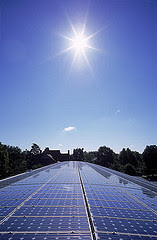About 150 small solar energy developments in Ontario were able to breathe a sigh of relief this week as their operations are now to be included in the new feed-in tariffs, as long as the systems were purchased before October 1st, 2009, and they make their status known and registered by Nov. 30. These home and small-scale solar photovoltaic systems did not meet the province's new 40% local content minimum requirement, and were initially excluded from the program.
Toronto Star article on revisions to Ontario's solar feed-in tariff program
Now that the regional issue has been resolved, an international dispute is simmering over the new legislation. Germany's BSW-Solar (solar energy industry association) has already gone on the record as being opposed to the rules, and the Toronto Star quotes an industry source saying major international photovoltaic solar module manufacturers such as SunPower, First Solar, Mitsubishi, Sanyo and Schuco have qualms with the legislation.
"The actions taken in Ontario directly contravene Canada's international trade commitments and place foreign solar equipment makers at a serious competitive disadvantage," the association said.
"We respectfully request that you raise this issue with the appropriate Canadian federal and Ontario provincial authorities, indicating that the European Union will consider seriously all available options to resolve the matter successfully."
- Germany's solar-industries association, BSW-Solar
Let's look at how these rules can be improved. The new rules, which went into effect Oct. 1, require that small rooftop solar systems contain 40 per cent local content as a combination of labour and equipment.
Larger systems must meet a 50 per cent threshold. Starting in two years that target will rise to 60 per cent. The Ontario solar feed-in tariff program provides between 44.3 and 80.2 cents per kilowatt-hour.
Ontario doesn't want to exclude the big solar companies and doesn't want to violate the WTO "national treatment" mandate and so must take these concerns very seriously. One way to change the legislation in an internationally positive manner would be to shift the focus from exclusionary and make it inclusive:
ALL solar systems eligible for 22 to 40 cents per kilowatt-hour.
Systems meeting 50% of local content targets will receive a 50% bonus and get rates of 33 to 60 cents an hour.
Systems meeting or exceeding 100% of the local content requirements would receive a 100% bonus and get rates 44 to 80 cents per kwh.
Opening the game up to all players shifts the focus to how much will we get paid, and away from why can't we play.
It may also be advantageous to give the rules a term, perhaps ten years, so that the local content requirements ramp up initially over the first two to three years, but then decline until the ten year term expires and all global products and systems are treated equally.
Our focus on nuclear and coal has left Ontario playing catch-up with regard to solar, wind, geothermal and biogas projects, so we really have to get PV right to attract the manufacturing, distribution and installation employment opportunities this rapidly growing industry can provide.
Tyler Hamilton story on BSW-Solar's opposition to Ontario solar rules
I'll be covering Ontario wind energy news at my Wind Energy Stocks Investing blog.
The Benefits of Grid-Tied Commercial Solar Systems
8 months ago
